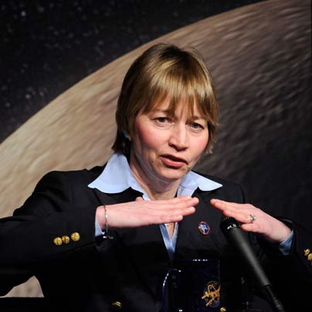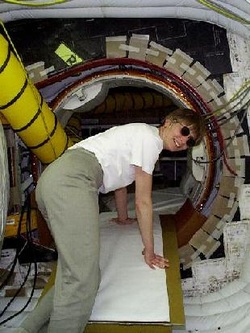To Infinity and Beyond - Dr. Maria Zuber heads NASA's Mission GRAIL! Dr. Maria Zuber
src: http://web.mit.edu/newsoffice/2008/
9/11/2011
By Alexandra Perkins Reach for the stars! Or how about the moon? Dr. Maria Zuber, Professor of Geophysics at MIT, is doing just that. Zuber is the principal investigator of NASA's Gravity Recovery and Interior Laboratory mission, or GRAIL, which will send two satellites to orbit the moon and measure the its gravitational field. The mission is part of NASA's Discovery Program, and is scheduled to launch September 8th. The resulting gravity measurements will increase understanding of the moon's interior structure and thermal evolution. As principal investigator, Zuber is responsible for ensuring these objectives are met. Studying the moon’s gravitational fields can provide answers to terrestrial evolution more broadly. The moon has a well-preserved surface and is close-by, as far as celestial bodies go. Beyond this, Zuber notes that “the processes that affected the early moon also affected other terrestrial planets, and so by studying the moon we expect to learn about the early history of all terrestrial planets, including Earth." However, sending satellites into orbit around the moon will be challenging because of the moon’s unique inner structure. The moon's gravity field is one of the most uneven in the solar system, due to mass concentrations, or "mascons," on the moon's Earth-facing side. The mascons' gravitational fields are much stronger than those of other parts of the moon's crust.[1] Beyond this, the spacecraft on the GRAIL mission must fly in exact formation without the ability to use GPS, a task that is incredibly difficult for any spacecraft orbiting a celestial body. Zuber notes that this, coupled with the moon’s gravitational anomalies, is one of the mission’s greatest challenges.
And still, the mission has yet another objective. Zuber teamed with Sally Ride, the first American woman to go into space, to implement an Education and Public Outreach program to the GRAIL mission, focused on middle school girls. The program, lasting for approximately 80 days, will allow girls from around the country to select areas on the moon, which will be photographed with cameras on each spacecraft.[2] The students will be able to access the images and use knowledge acquired about the mission and image-targeting software to study lunar characteristics. Zuber and Ride hope that this exercise will demonstrate how rewarding the study of math, science, and technology can be. In a male-dominated field, Zuber is an inspirational figure for young girls.
 At Kennedy Space Center Pad;
SRC: http://www-geodyn.mit.edu/mtz.endeavor.entry.jpg She has been involved in missions since the Mars Observer Mission from 1990-1993, in which she was the only woman scientist.[3] Zuber seeks to encourage girl students whenever she gets the chance: "The biggest advice I can give to girls in middle school [is] to take the advanced math track that allows them to take calculus and AP science in high school. Go for it, girls."
As the September 8th launch period approaches, Zuber is optimistic about the mission and about future advances in space science for the United States. As she states, "When you talk about what makes America great, space has been a part of that discussion for over 50 years...The technological, scientific, education, economic and national pride aspects of [NASA's planetary] program are exemplary." With Zuber's leadership, there is little doubt that the GRAIL mission will be a great success. Sources: [1] NASA Science, Science News. "Bizarre Lunar Orbits," http://science.nasa.gov/science-news/science-at-nasa/2006/06nov_loworbit/ (Nov. 6, 2006). [2] Grail Moon Kam. "About Grail MoonKam.," https://moonkam.ucsd.edu/about (Sep. 9, 2011). [3] Planetary Geodynamics. "Maria Zuber," http://www-geodyn.mit.edu/zubersite/vitae.html (Sep. 9, 2011). --- Liked this article? Check out more features! About the Author

Alexandra Perkins is a columnist for Scientista and a product manager at Satcon Technology, a solar energy firm. She grew up in Seattle and graduated from Harvard College in 2010. While at Harvard, she studied History and Literature with a focus in Postcolonial Studies, and was a resident of Kirkland House. After graduation, she lived in Israel for six months and worked for a solar energy start-up. She has also spent time in India and France, working on human rights issues.
Comments?
|
The Scientista Foundation, Inc. All Rights Reserved © 2011-2021 | Based in NY | [email protected]
The Network for Pre-Professional Women in Science and Engineering
The Scientista Foundation is a registered 501(c)(3) -- Donate!
The Network for Pre-Professional Women in Science and Engineering
The Scientista Foundation is a registered 501(c)(3) -- Donate!
